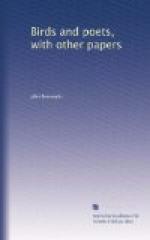A prominent April bird, that one does not have to go to the woods or away from his own door to see and hear, is the hardy and ever-welcome meadowlark. What a twang there is about this bird, and what vigor! It smacks of the soil. It is the winged embodiment of the spirit of our spring meadows. What emphasis in its "z-d-t, z-d-t" and what character in its long, piercing note! Its straight, tapering, sharp beak is typical of its voice. Its note goes like a shaft from a crossbow; it is a little too sharp and piercing when near at hand, but, heard in the proper perspective, it is eminently melodious and pleasing. It is one of the major notes of the fields at this season. In fact, it easily dominates all others. "Spring o’ the year! spring o’ the year!" it says, with a long-drawn breath, a little plaintive, but not complaining or melancholy. At times it indulges in something much more intricate and lark-like while hovering on the wing in midair, but a song is beyond the compass of its instrument, and the attempt usually ends in a breakdown. A clear, sweet, strong, high-keyed note, uttered from some knoll or rock, or stake in the fence, is its proper vocal performance. It has the build and walk and flight of the quail and the grouse. It gets up before you in much the same manner, and falls an easy prey to the crack shot. Its yellow breast, surmounted by a black crescent, it need not be ashamed to turn to the morning sun, while its coat of mottled gray is in perfect keeping with the stubble amid which it walks. The two lateral white quills in its tail seem strictly in character. These quills spring from a dash of scorn and defiance in the bird’s make-up. By the aid of these, it can almost emit a flash as it struts about the fields and jerks out its sharp notes. They give a rayed, a definite and piquant expression to its movements. This bird is not properly a lark, but a starling, say the ornithologists, though it is lark-like in its habits, being a walker and entirely a ground-bird. Its color also allies it to the true lark. I believe there is no bird in the English or European fields that answers to this hardy pedestrian of our meadows. He is a true American, and his note one of our characteristic April sounds.
Another marked April note, proceeding sometimes from the meadows, but more frequently from the rough pastures and borders of the woods, is the call of the high-hole, or golden-shafted woodpecker. It is quite as strong as that of the meadowlark, but not so long-drawn and piercing. It is a succession of short notes rapidly uttered, as if the bird said "if-if-if-if-if-if-if." The notes of the ordinary downy and hairy woodpeckers suggest, in some way. the sound of a steel punch; but that of the high-hole is much softer, and strikes on the ear with real springtime melody. The high-hole is not so much a wood-pecker as he is a ground-pecker. He subsists largely on ants and crickets, and does not appear till they are to be found.




